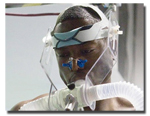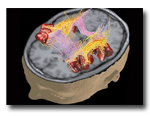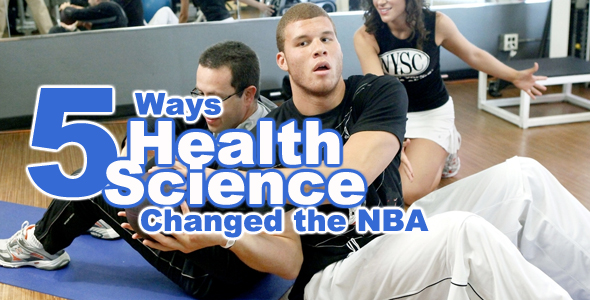Everyone in the NBA is a great athlete, yes, even Brian Scalabrine, but physical gifts only take players so far. The great are always working hard to improve ever aspect of their games, and now they are getting a little help from science to run faster, jump higher, and stay healthy through an 82 game season. These new scientific processes and procedures are creating a new generation of athletes, capable of doing things we have never seen before.
Carbohydrate Burning Levels
 Some NBA players are now going through testing to see exactly how many carbohydrates they are burning through when they are working hard. These tests involve a player being hooked up to various equipment and being put through a vigorous workout and seeing the results. Dwyane Wade has been doing this with Gatorade lab, and has found out that he burns through more carbohydrates than an average NBA player. This helps to pick out meal plans that will allow him to sustain his athletic performances for longer without getting worn out, which can lead to more big plays at the end of long games.
Some NBA players are now going through testing to see exactly how many carbohydrates they are burning through when they are working hard. These tests involve a player being hooked up to various equipment and being put through a vigorous workout and seeing the results. Dwyane Wade has been doing this with Gatorade lab, and has found out that he burns through more carbohydrates than an average NBA player. This helps to pick out meal plans that will allow him to sustain his athletic performances for longer without getting worn out, which can lead to more big plays at the end of long games.
Studying Biomechanics
 Basketball is an extremely physical sport, with constant collisions, hard cuts, and strain on pretty much every muscle in the body. Companies like Applied Sports Science are working with athletes such as Deron Williams to see how much strain is placed on specific parts of the body during various basketball moves, such as jumps, cuts, and spins. When combined with studies on previous injuries, studying the specific biomechanics of a player’s movement helps to see what muscle areas need to be built up to be able to pull off those highlight reel moves without suffering injuries. If needed, players can also use this information to change how they train, learning new moves that are just as or more effective that put less strain on joints like the knees, keeping them healthier for their team.
Basketball is an extremely physical sport, with constant collisions, hard cuts, and strain on pretty much every muscle in the body. Companies like Applied Sports Science are working with athletes such as Deron Williams to see how much strain is placed on specific parts of the body during various basketball moves, such as jumps, cuts, and spins. When combined with studies on previous injuries, studying the specific biomechanics of a player’s movement helps to see what muscle areas need to be built up to be able to pull off those highlight reel moves without suffering injuries. If needed, players can also use this information to change how they train, learning new moves that are just as or more effective that put less strain on joints like the knees, keeping them healthier for their team.
Neurotechnology
 Sports psychologists have been available to players for a long time, because everybody knows that the mental state of a player directly affects how well they perform. Things are getting more scientific with this now, as players are now having their actual brainwaves studied while they perform reaction tests and are put in game-like situations. The idea behind this kind of testing is promoting positive brain wave functions, and teaching a player what it feels like when their brain is functioning optimally and how to reach that state through techniques such as improved sleep quality and concentration. Players can use these techniques to stay focused during games and become more efficient in their thought processes, creating a smoother game.
Sports psychologists have been available to players for a long time, because everybody knows that the mental state of a player directly affects how well they perform. Things are getting more scientific with this now, as players are now having their actual brainwaves studied while they perform reaction tests and are put in game-like situations. The idea behind this kind of testing is promoting positive brain wave functions, and teaching a player what it feels like when their brain is functioning optimally and how to reach that state through techniques such as improved sleep quality and concentration. Players can use these techniques to stay focused during games and become more efficient in their thought processes, creating a smoother game.
Medical Advances
 There will always be injuries in basketball. That’s just a fact when you have giant athletic men in intensely physical athletic competitions. Science has been making much progress in treating these injuries, along with identifying which injuries have more long term dangers associated with them, such as concussions. But the advances work both ways, as there are some advances athletes have used for beating drug testing, learn more to see what I mean. These advances are why there are new concussion rules in place for the NFL and why the NBA is working towards implementing its own guidelines.
There will always be injuries in basketball. That’s just a fact when you have giant athletic men in intensely physical athletic competitions. Science has been making much progress in treating these injuries, along with identifying which injuries have more long term dangers associated with them, such as concussions. But the advances work both ways, as there are some advances athletes have used for beating drug testing, learn more to see what I mean. These advances are why there are new concussion rules in place for the NFL and why the NBA is working towards implementing its own guidelines.
These health science advances are also working to extend the careers of athletes. It’s hard to forget the horrific injury suffered by Shaun Livingston, where his knee basically exploded. Modern surgical techniques, that are being improved every year, allowed him to come back from that injury and continue his career in the NBA after an injury that looked like a career killer.
Energy Systems
 While Dwyane Wade is working with Gatorade labs to study how his body works with hydration and carbohydrates, there are some tests being done for NBA players that are going even further into researching how players’ energy systems work. There has been much research done into how an aerobic sport like basketball burns energy, and how the body relies on ATP (adenosine triphosphate) for energy. These more complex studies give a more detailed view of how an athlete’s body is working, and what changes can be made to give them an edge over their opponent.
While Dwyane Wade is working with Gatorade labs to study how his body works with hydration and carbohydrates, there are some tests being done for NBA players that are going even further into researching how players’ energy systems work. There has been much research done into how an aerobic sport like basketball burns energy, and how the body relies on ATP (adenosine triphosphate) for energy. These more complex studies give a more detailed view of how an athlete’s body is working, and what changes can be made to give them an edge over their opponent.
Resources:
















